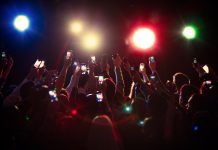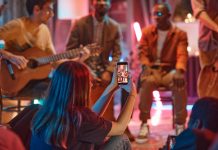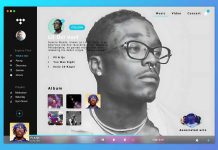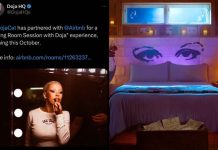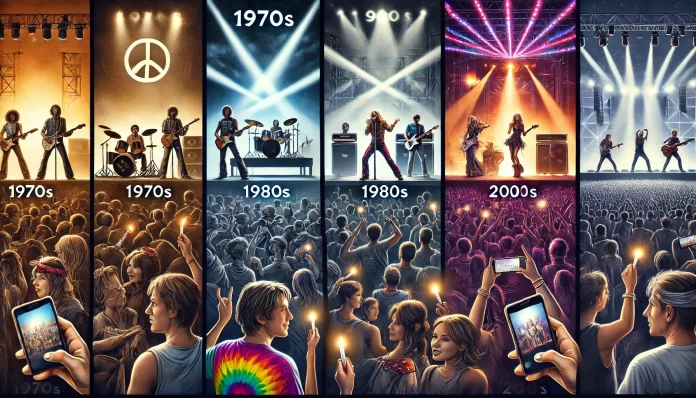
Concerts have undergone profound transformations over the last four decades, reflecting cultural shifts, technological advancements, and changing audience expectations. What started as raw, intimate musical gatherings in the 1970s has evolved into grand spectacles by the 2000s, making live music not just an auditory experience but a full-fledged multimedia event. This article explores the evolution of concert standards over four decades, focusing on production values, audience behavior, showmanship, setlists, and the overall fan experience.
Historical Context: Concert Trends Across the Decades
1970s: Raw Energy and Cultural Revolution
Concerts in the 1970s were often characterized by simplicity, where music took precedence over visuals. Iconic acts like Led Zeppelin and Pink Floyd led performances driven by musicianship rather than elaborate staging. These shows often echoed the era’s countercultural movements, serving as platforms for protest and social change.
1980s: The Age of Excess
With the rise of MTV, the 1980s saw an explosion in arena concerts, with larger-than-life artists like Michael Jackson and Madonna turning their performances into theatrical productions. Choreography, pyrotechnics, and extravagant costumes became the norm, marking the era of spectacle-driven shows.
1990s: Grunge and Authenticity
The 1990s were defined by the raw, unpolished energy of bands like Nirvana and Pearl Jam. This decade rejected the excess of the 80s, focusing instead on authenticity and stripped-down performances. Concurrently, the rise of hip-hop introduced a new dynamic to live music, with artists like Tupac Shakur leading electrifying performances.
2000s: Digital Integration and Immersive Spectacles
By the 2000s, technological advancements reshaped the live concert experience. Major acts like Beyoncé and Coldplay integrated multimedia elements such as LED screens and 3D projections. Concerts were no longer just live experiences; they became digital moments, amplified by the rise of smartphones and social media.
Production Values: From Minimalism to Spectacle
1970s: The Era of Pure Sound
Concerts in the 1970s were largely minimalist. Stages were simple, with the focus on the sound rather than visuals. Bands like The Grateful Dead delivered long, improvisational performances, and while there were early experiments with surround sound, staging remained relatively basic.
1980s: Spectacular Stage Designs
With artists like David Bowie and Prince, the 1980s embraced elaborate stagecraft. Concerts featured complex lighting, costume changes, and synchronized performances. The evolution of sound technology allowed for better amplification, enhancing the overall live experience.
1990s: A Return to Raw Power
The stripped-down aesthetics of grunge bands reflected a return to basics. However, electronic acts and rave culture introduced vibrant light shows and experimental sounds. In hip-hop, turntables and intricate DJ setups became a central feature of live shows.
2000s: High-Tech, Immersive Productions
By the 2000s, technological integration reached new heights. Artists such as U2 and Kanye West employed massive LED screens and advanced sound systems to create immersive, visually spectacular shows. Digital integration, such as live-streaming and augmented reality, elevated concert experiences further.
Audience Expectations: Evolution of Concert Behavior
1970s: A Collective Experience
Concerts in the 70s were communal, with fans deeply engaged in the music and the cultural movements of the time. The audience often shared a sense of rebellion, creating a unified, almost ritualistic atmosphere.
1980s: The Spectacle-Driven Experience
In the 80s, audiences sought spectacle. Fans wanted to witness larger-than-life performances, with artists delivering high-energy, visually stunning shows. The rise of pop superstars meant that fans often idolized performers as entertainers, not just musicians.
1990s: Authenticity and Intimacy
In contrast, the 1990s emphasized raw emotional connection. Fans at grunge or hip-hop concerts expected sincerity, with shows focused on authenticity and unfiltered emotions. Hip-hop shows, in particular, fostered direct interaction between the artist and the audience.
2000s: The Social Media Effect
The rise of smartphones transformed the concert experience in the 2000s. Fans began documenting concerts in real-time, shifting focus from pure engagement to capturing and sharing moments. Concerts became digital experiences shared on platforms like Instagram and Twitter, making them globally accessible.
Setlist Composition: Hits, Deep Cuts, and Themed Tours
1970s: Improvisation and Jams
Setlists in the 1970s often featured extended jams and improvisation. Bands like The Allman Brothers were known for lengthy sets, mixing popular hits with deep cuts, creating a unique experience each night.
1980s: Hit-Driven Shows
In the 1980s, the focus shifted to structured, hit-driven performances. Pop icons like Madonna carefully crafted setlists designed to feature their biggest hits, making shows feel like greatest-hits concerts packed with high-energy performances.
1990s: Full Albums and Fan Favorites
The 90s saw a resurgence in full-album performances, with bands like Radiohead playing entire sections of their critically acclaimed albums. Hip-hop artists mixed freestyles with crowd-pleasing hits, creating dynamic setlists.
2000s: Tailored and Themed Setlists
Artists in the 2000s began designing thematic tours, with setlists revolving around specific albums. Encore performances and surprise guest appearances became common, keeping audiences engaged and adding unpredictability to the shows.
Cultural Significance: Concerts as Reflections of Their Time
1970s: Concerts as Countercultural Movements
Concerts in the 70s were often political, reflecting the counterculture of the time. Events like Woodstock symbolized peace, love, and resistance to war, with music serving as a unifying force for activism.
1980s: Excess and Glamour
The 80s mirrored the societal focus on wealth and indulgence. Concerts became extravagant, with artists embodying the decade’s excess in both sound and style. Shows were bigger, louder, and more glamorous than ever before.
1990s: Social Commentary and Raw Emotion
By the 90s, concerts became spaces for introspection and social commentary. The grunge scene brought raw emotion to the stage, while hip-hop addressed pressing issues like race and inequality through high-energy performances.
2000s: Global Connectivity and Awareness
With the rise of digital platforms, concerts like Live 8 became global events. Social awareness was at the forefront, with artists using their platforms to advocate for change on issues such as climate change, poverty, and inequality.
Conclusion: The Evolution of Concert Standards
Music Industry Weekly understands that over the last four decades, concert standards have undergone dramatic changes, driven by cultural shifts, advancements in technology, and evolving audience expectations. From the minimalist shows of the 1970s to the high-tech, immersive spectacles of the 2000s, concerts have continuously adapted to reflect the times. As live music continues to evolve, it remains a central part of culture, connecting generations and offering unforgettable shared experiences.



